Snorkeling in Crete: Best Locations to Snorkel in Crete
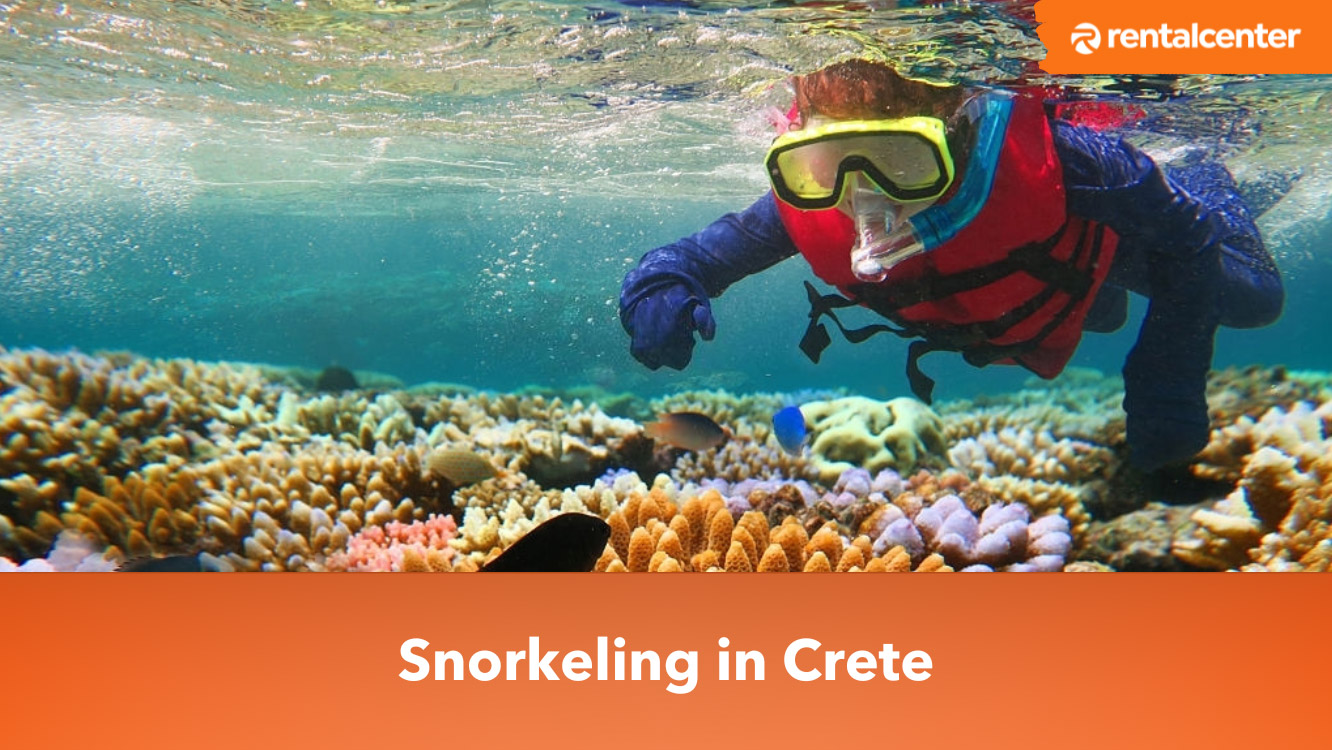
Snorkeling in Crete is highlighted by its clear waters and abundant marine life. The visibility can reach over 30 meters, ideal for observing various species like fish, octopuses, sea turtles, and the Mediterranean monk seal. The rocky seabeds and underwater caves enhance the underwater experience. The optimal snorkeling season is May to October, with water temperatures between 20°C and 27°C. For fewer crowds and good conditions, June or September are recommended.
Top snorkeling locations in Crete include Skinaria Beach, notable for its clear waters and rugged seabed; Elounda and Spinalonga Peninsula; Elafonissi Beach, known for pink sand and turquoise waters; Chrissi Island, recognized for its warm, shallow waters rich in marine life; and Mononaftis Beach, known for its clarity and safety. Boat trips to remote spots like Dia Island offer access to pristine underwater environments.
What Makes the Seas of Crete so Ideal for Snorkeling?
The seas around Crete are ideal for snorkeling due to the island’s location, topography, and climate. The clear waters around Crete, with visibility extending beyond 30 meters, result from the absence of large rivers, minimizing sediment influx that could cloud the water. The rocky coastline and seabed, featuring caves, crevices, and reefs, provide diverse habitats for marine life and help maintain water clarity by limiting sand disturbance.
The island’s position in the southern Mediterranean Sea ensures warm water temperatures throughout the snorkeling season, ranging from 20°C in May to 27°C in August, allowing snorkelers to stay in the water comfortably for longer periods. The calm seas with minimal currents and waves, especially in sheltered bays and coves, facilitate snorkeling for all skill levels. Additionally, the high salinity of the Mediterranean Sea around Crete enhances buoyancy, helping snorkelers float easily and focus on the marine environment below.
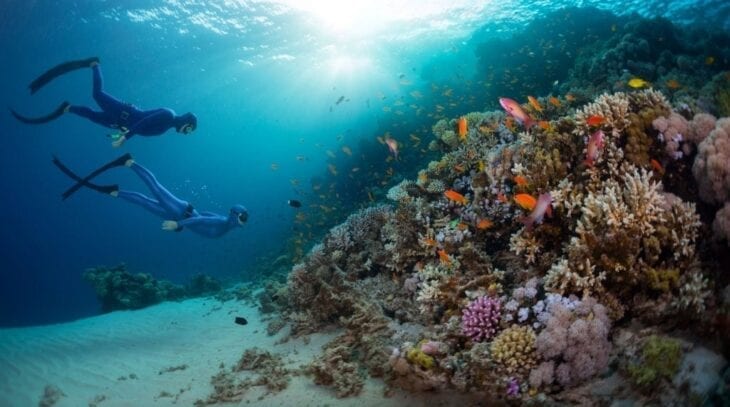
What are the best snorkeling spots in Crete?
Listed below are the best snorkeling spots in Crete:
- Elafonissi Beach: Elafonissi Beach is located southwest of Crete, with pink-hued sands and crystal-clear turquoise waters. The shallow lagoon and lack of strong currents make it ideal for snorkeling, especially for beginners and families with children. Elafonissi beach is 90.7 kilometers (56.37 miles) from Chania International Airport, and visitors can reach it by car, bus, or boat tour.
- Balos Lagoon: Balos Lagoon offers a unique snorkeling experience in its shallow, calm waters surrounded by white sandy beaches and rocky formations and is considered one of the most beautiful beaches in Greece. The best way to access the remote location of Balos Beach is by taking a boat tour from towns like Kissamos, 55.2 kilometers (34.31 miles) from Chania International Airport.
- Matala Beach: Matala Beach in the Heraklion region is famous for its cliffside caves, which were once inhabited by hippies in the 1960s and 1970s. Snorkelers can explore the remains of an ancient Roman port submerged in the crystal-clear waters along the rocky coastline. Matala Beach is 66 kilometers (41.02 miles) from Heraklion International Airport and can be reached by car or public transportation.
- Skinaria Beach: Skinaria Beach is known for its rugged underwater landscape and excellent visibility, making it a popular snorkeling destination on the south coast of Crete. This beach is 36.2 kilometers (22.5 miles) from Rethymno and can be accessed by car or boat tours.
- Chrissi Island: Chrissi Island, also known as “Golden Island,” is a small, uninhabited island located 2 kilometers (1.24 miles) south of Ierapetra, on Crete’s southeast coast. Visitors can reach the island by boat from Ierapetra, which is 61.3 kilometers (38.1 miles) from Sitia Airport. The island’s crystal-clear waters, shallow lagoons, and sandy beaches make it an ideal spot for snorkeling, with the opportunity to explore the rich underwater world surrounding the island.
- Kolokytha Beach: Kolokytha Beach is a lesser-known snorkeling spot in Crete that offers a peaceful and less crowded experience near Elounda. This small rocky beach is accessible via a scenic road and provides opportunities to explore the clear waters and marine life. It is 3.2 kilometers (1.99 miles) from Elounda.
- Dia Island: Dia Island is a popular snorkeling destination known for its clear waters and rich marine life. It is 14.4 kilometers (8.95 miles) north of Heraklion. Visitors can reach the island by boat from Heraklion, with tours departing daily during summer. The island’s rocky coastline and secluded coves offer excellent snorkeling conditions, with the chance to spot various fish, octopuses, and monk seals.
- Almyrida Beach: Almyrida Beach, located 30.2 kilometers (18.77 miles) east of Chania, is another popular snorkeling destination on Crete’s north coast. Visitors can easily reach the beach by car or public bus from Chania International Airport. The beach’s rocky areas and small coves provide ample opportunities for snorkeling, with various fish and other marine life to observe.
- Agia Pelagia: Agia Pelagia is a popular snorkeling spot known for its clear waters and diverse marine life 26.3 kilometers (16.35 miles) west of Heraklion. Visitors can reach Agia Pelagia by car or public bus from Heraklion International Airport, which is 26.7 kilometers (16.59 miles) away. The bay offers various snorkeling opportunities, including reefs, canyons, and underwater caves, making it suitable for beginners and experienced snorkelers.
- Kedrodasos Beach: Kedrodasos offers a more secluded and less crowded snorkeling experience with its untouched white sands and dwarf juniper tree grove, just a short distance from the popular Elafonissi Beach. It is 91.1 kilometers (56.62 miles) from Chania International Airport and can be accessed by car or taxi.
- Frangokastello Beach: Frangokastello Beach is located near the historic Frangokastello Castle, 14.7 kilometers (9.14 miles) from Sfakia. Visitors can reach the beach by car or public bus from Chania, which is 77.8 kilometers (48.35 miles) away. The beach comprises three distinct areas, with the pebbly western section offering the best snorkeling opportunities due to its rocky seabed.
- Bali Beach: Bali Beach is a popular snorkeling spot with its calm waters, rocky coves, and diverse marine life on the northern coast of Crete. It is 30 kilometers (18.65 miles) from Rethymno and can be accessed by car or public transportation.
- Plakias Beach: Plakias Beach is a long, sandy beach in the Rethymno region and is a popular spot for swimming, snorkeling, and other water sports. The clear waters and rocky areas make it an excellent place to explore Crete’s underwater world. Plakias Beach is 40 kilometers (24.85 miles) south of Rethymno and can be reached by car or bus.
- Ammoudara Beach: Ammoudara Beach, located just west of Heraklion, this long, sandy beach offers relatively calm waters and a family-friendly atmosphere for snorkeling. Ammoudara Beach is 11.1 kilometers (6.9 miles) from Heraklion International Airport, making it easily accessible by car or public transportation.
- Agiofarago Beach: Agiofarago Beach, this bay, accessible after a hike, offers calm, crystal-clear waters and a rocky seabed perfect for snorkeling. It is 86.5 kilometers (53.76 miles) south of Rethymno and can be reached by car and then a short hike.
- Paleochora Beaches: Paleochora Beaches, this area on the southern coast of Chania region, has a collection of beaches, including Pahia Ammos, Chalikia, and Anydri, which offer excellent snorkeling opportunities due to their rocky seabeds and diverse marine life. Paleochora is 88.5 kilometers (55 miles) from Chania International Airport.
- Voulisma Beach: Voulisma Beach is 71 kilometers (44.13 miles) from Heraklion International Airport and is known for its crystal-clear waters and rocky seabed, making it an ideal spot for snorkeling in the Bay of Mirabello near Agios Nikolaos.
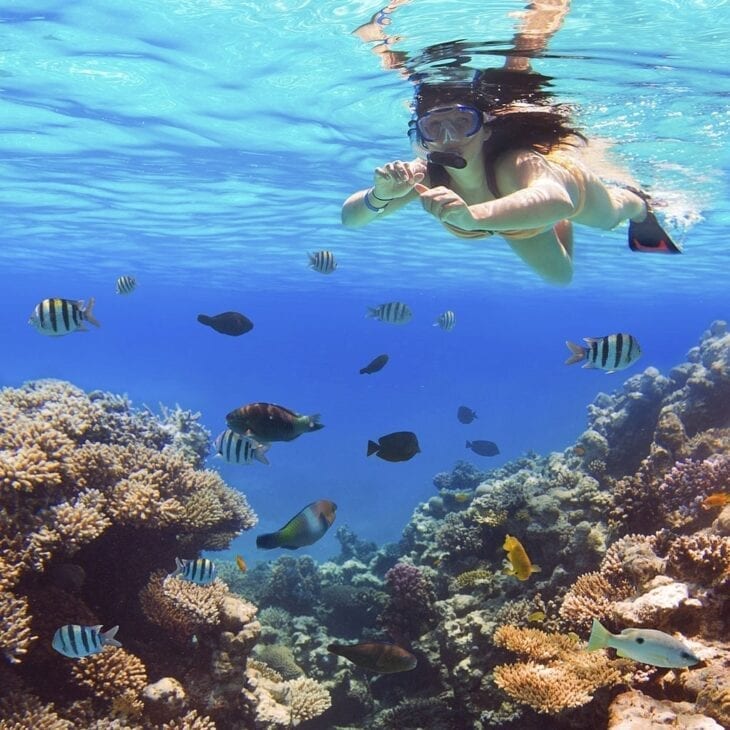
Where to go Snorkeling along the South Coast of Crete?
Listed below are the places to enjoy snorkeling along the South Coast of Crete:
- Sougia Beach: Sougia Beach is one of the most popular spots for swimming and snorkeling on the south coast of the Chania region. It lies 80.1 kilometers (49.78 miles) from Chania International Airport, and visitors can reach the beach by car or public bus. The clear waters and rocky seabed make it an excellent spot for snorkeling experts.
- Plakias Beach: Plakias Beach is another popular snorkeling destination on Crete’s south coast, which is 40 kilometers (24.85 miles) south of Rethymno. Visitors can access the beach by car or public bus from Rethymno, which is 80 kilometers (49.71 miles) from Heraklion International Airport. The beach offers a long stretch of sand, clear waters, and a variety of underwater landscapes to explore.
- Frangokastello Beach: Frangokastello Beach is located near the historic Frangokastello Castle, 14.7 kilometers (9.14 miles) from Sfakia. Visitors can reach the beach by car or public bus from Chania, which is 77.8 kilometers (48.35 miles) away. The beach comprises three distinct areas, with the pebbly western section offering the best snorkeling opportunities due to its rocky seabed.
- Elafonissi Beach: Elafonissi, a small island and beach located on the southwest coast of Crete, is famous for its clear turquoise waters and pink sandy shores. It is 90.7 kilometers (56.37 miles) from Chania International Airport, and visitors can reach the beach by car or public bus. The beach’s shallow lagoon and rocky formations provide excellent snorkeling conditions for all skill levels.
- Matala Beach: Matala Beach is on the south coast of the Heraklion region and is known for its unique rock formations and caves. It is 66 kilometers (41.02 miles) from Heraklion International Airport, and visitors can reach the beach by car or public bus. The beach offers good snorkeling opportunities, particularly around the remains of the ancient Roman port on either side of the rocks.
- Agiofarago Beach: Agiofarago is a secluded beach located on the south coast of the Heraklion region, 74.6 kilometers (46.36 miles) from Heraklion International Airport. Visitors can reach the beach by car and then hike for 20 minutes from the parking area. The beach’s clear waters, rock formations, and sea caves make it an attractive snorkeling spot, while its remote location ensures a more peaceful experience.
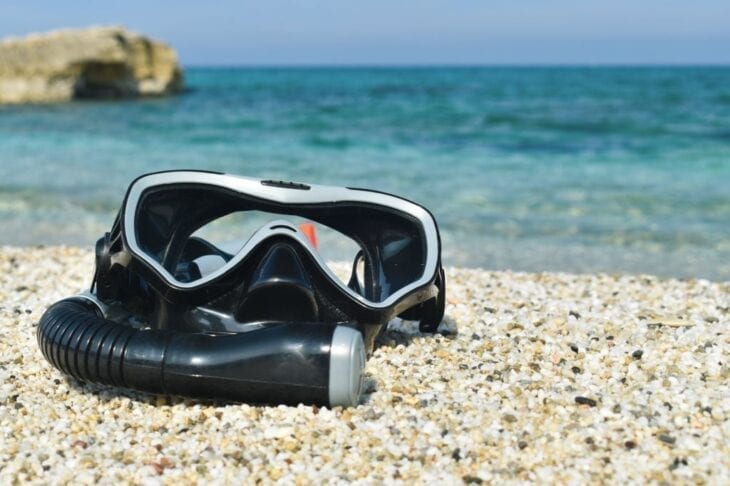
Where to go Snorkeling on the North Coast of Crete?
Listed below are the places to enjoy snorkeling on the North Coast of Crete:
- Agia Pelagia: Agia Pelagia is a popular snorkeling spot known for its clear waters and diverse marine life 26.3 kilometers (16.35 miles) west of Heraklion. Visitors can reach Agia Pelagia by car or public bus from Heraklion International Airport, which is 26.7 kilometers (16.59 miles) away. The bay offers various snorkeling opportunities, including reefs, canyons, and underwater caves, making it suitable for beginners and experienced snorkelers.
- Petres Beach: Petres Beach is a favorite among snorkeling lovers between Rethymno and Chania. It is 53.8 kilometers (33.44 miles) from Chania International Airport and 95.1 kilometers (59.11 miles) from Heraklion International Airport. Visitors can access the beach by car or public bus from either city. The rocky seabed and clear waters make it an excellent spot for exploring the underwater world.
- Almyrida Beach: Almyrida Beach, located 30.2 kilometers (18.77 miles) east of Chania, is another popular snorkeling destination on Crete’s north coast. Visitors can easily reach the beach by car or public bus from Chania International Airport. The beach’s rocky areas and small coves provide ample opportunities for snorkeling, with various fish and other marine life to observe.
- Elounda: Elounda, located 10.4 kilometers (6.46 miles) north of Agios Nikolaos, is known for its beautiful beaches and snorkeling spots. It is 67.1 kilometers (41.7 miles) from Heraklion International Airport, and visitors can reach Elounda by car or public bus. The nearby Kolokitha beach, accessible by foot or boat, offers good snorkeling conditions, with clear waters and interesting rock formations. The submerged ruins of the ancient city of Olous, located off the coast of Elounda, provide a unique underwater experience for snorkelers.
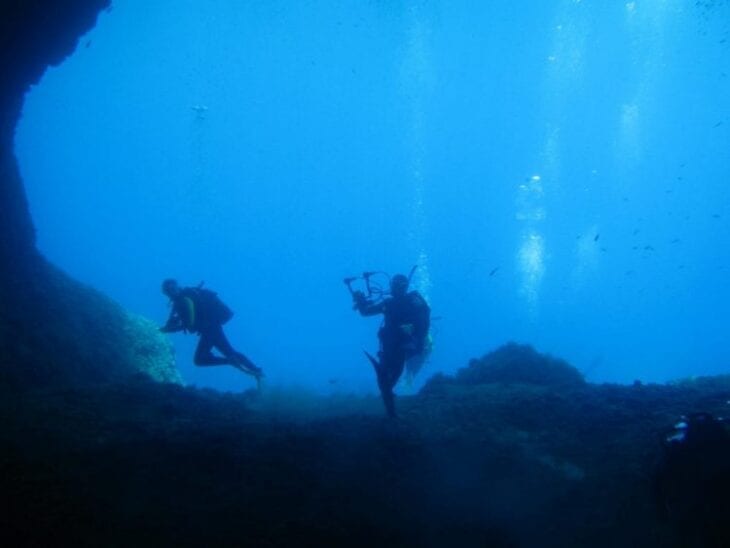
In what smaller islands can you snorkel in Crete?
Listed below are the smaller Islands in Crete that visitors can snorkel:
- Dia Island: Dia Island is a popular snorkeling destination known for its clear waters and rich marine life. It is 14.4 kilometers (8.95 miles) north of Heraklion. Visitors can reach the island by boat from Heraklion, with tours departing daily during summer. The island’s rocky coastline and secluded coves offer excellent snorkeling conditions, with the chance to spot various fish, octopuses, and monk seals.
- Chrissi Island: Chrissi Island, also known as “Golden Island,” is a small, uninhabited island located 2 kilometers (1.24 miles) south of Ierapetra, on Crete’s southeast coast. Visitors can reach the island by boat from Ierapetra, which is 61.3 kilometers (38.1 miles) from Sitia Airport. The island’s crystal-clear waters, shallow lagoons, and sandy beaches make it an ideal spot for snorkeling, with the opportunity to explore the rich underwater world surrounding the island.
- Gavdos Island: Gavdos Island, located 26 kilometers (16.16 miles) south of Hora Sfakion, is the southernmost point of Europe. Visitors can reach Gavdos island by ferry from Hora Sfakion or Paleochora, which are 76.1 kilometers (47.3 miles) and 88.5 kilometers (55 miles) from Chania International Airport. The island’s remote location and unspoiled beaches offer a unique snorkeling experience with clear waters and diverse marine life. Snorkelers can explore the rocky coves and reefs around the island, particularly at Agios Ioannis and Tripiti beaches.
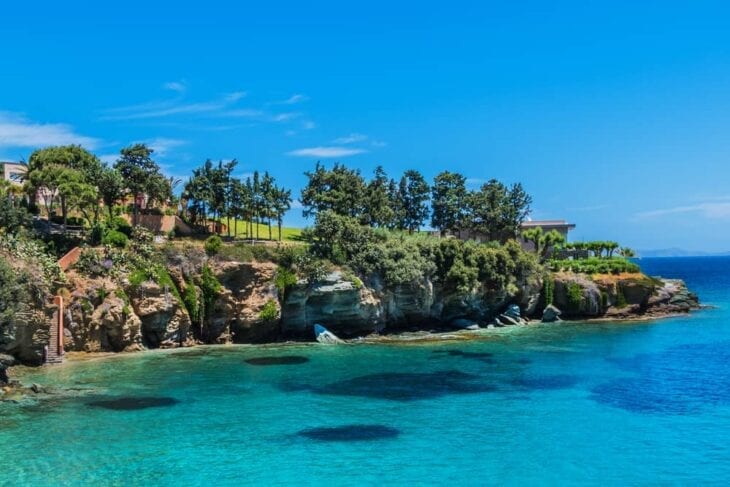
What are some important safety tips for snorkeling in Crete?
Listed below are some of the important safety tips for snorkeling in Crete:
- Know one’s swimming abilities: Snorkelers should assess their swimming skills and comfort level before attempting to snorkel. Those who are not strong swimmers should consider taking a snorkeling lesson or joining a guided tour to ensure a safe and enjoyable experience.
- Check weather and sea conditions: Snorkelers must check the weather forecast and sea conditions before entering the water. They should avoid snorkeling in rough seas, strong currents, or during storms and seek a more sheltered location or postpone the activity if conditions are unfavorable.
- Use proper snorkeling equipment: Snorkelers must have well-fitting and functional gear, including a mask, snorkel, and fins. If renting equipment, they should check its condition and ask for assistance if needed, as ill-fitting or faulty gear can lead to discomfort or even dangerous situations.
- Protect one’s skin from the sun: Given Crete’s intense sun, especially during summer, snorkelers should always apply a high-SPF, waterproof sunscreen before entering the water and consider wearing a rash guard or t-shirt for added protection against painful sunburn and increased risk of skin damage and skin cancer.
- Stay hydrated: Snorkeling can be physically demanding, and dehydration can occur easily during long periods in the water. Snorkelers should drink plenty of water before and after their snorkeling session to avoid fatigue, headaches, and other dehydration-related health issues.
- Be aware of marine life: Most marine life in Crete is harmless, but snorkelers should be cautious of certain species like jellyfish, sea urchins, and some fish that can cause injuries. They should avoid touching or disturbing marine life, give animals ample space, and observe from a distance if unsure about a species.
- Snorkel with a buddy: Snorkelers should always have a partner or join a group when snorkeling, as having someone nearby can be crucial in an emergency or if assistance is needed. If snorkeling alone is necessary, they should inform someone on shore of their plans and expected return time.
- Know one’s limits: Snorkelers should listen to their bodies and take breaks when needed, especially if swimming against currents or in choppy water. If they feel fatigued, short of breath, or uncomfortable, they should return to shore and rest to avoid exhaustion and reduce the risk of accidents.
- Be cautious of boat traffic: When snorkeling in areas with boat traffic, snorkelers must stay aware of their surroundings, stick close to shore or snorkel in designated areas marked with buoys, and make themselves visible by waving an arm above the water and moving out of the way if a boat approaches.
- Learn basic first aid: Snorkelers should familiarize themselves with basic techniques for treating common injuries like jellyfish stings, cuts, or scrapes. They should carry a small first aid kit with essentials and know how to contact local authorities or medical services for assistance in a serious emergency.
What is the best time of the year to snorkel in Crete?
The best time for snorkeling in Crete is from May to October when the weather is warm, and the water temperatures are comfortable for extended exploration. During these months, the air temperature ranges from 20°C to 30°C, and the water temperature varies between 20°C and 27°C. The warmest months, July and August, are also the peak tourist season, leading to crowded beaches and snorkeling spots. For a more relaxed experience with fewer crowds, June or September are ideal, with pleasant air temperatures around 25°C and water temperatures between 22°C and 25°C. The slightly cooler temperatures in these months enhance underwater visibility as the cooler water supports more dissolved oxygen, allowing clearer conditions for observing marine life.
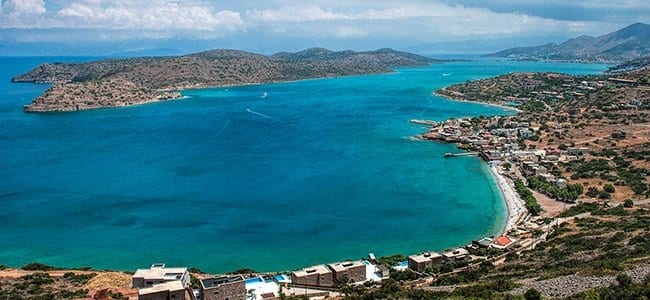
What is the best time to visit Crete?
The best time to visit Crete varies depending on personal preferences and the desired experience. Summer, from June to August, is the busiest season, popular for its hot, dry weather, ideal for beach holidays and water activities. The island’s beaches, clear waters, and beach resorts attract a global audience, especially during school breaks and vacation times. Tourist attractions like the Palace of Knossos, Samaria Gorge, and Balos Beach are best visited in summer, though accommodation prices are higher, so early booking is recommended.
Is Snorkeling in Crete an all-season activity?
Yes, snorkeling in Crete is an all-season activity. Snorkeling in Crete is feasible year-round, though conditions vary. From November to April, the water temperature stays above 16°C, suitable for snorkeling with appropriate gear like a wetsuit. During these months, air temperatures range from 10°C to 20°C, allowing for enjoyable snorkeling on calm, sunny days. However, the optimal snorkeling conditions occur from May to October, offering more comfortable experiences. Winter brings more unpredictable weather, with potential rain, wind, and rough seas that can impact visibility and overall snorkeling conditions. Additionally, snorkeling services may reduce their hours or close during the off-season, so it is crucial to plan and confirm availability in advance.
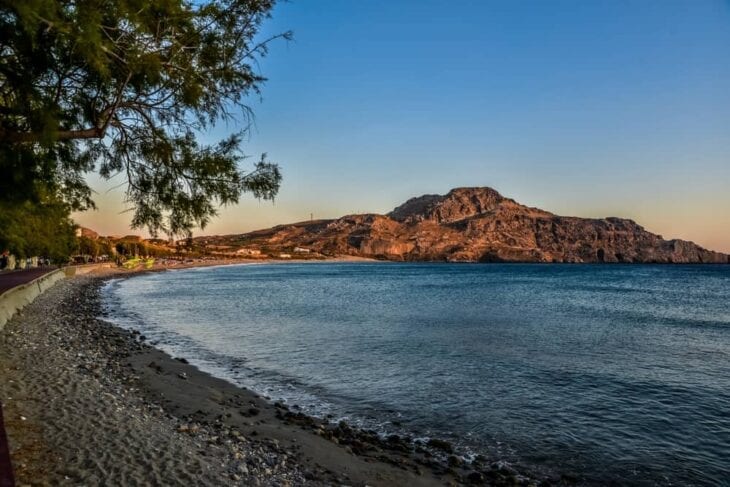
Is Crete good for beginners to snorkel?
Yes, Crete is ideal for beginner snorkelers due to its numerous sheltered bays, coves, and beaches with calm, shallow waters. These locations offer a safe environment for beginners to practice and build confidence. Many snorkeling spots have gently sloping sandy bottoms or easy access points for safe water entry and exit. The island’s clear waters and excellent visibility allow novice snorkelers to easily observe diverse marine life close to shore. Beginners can benefit from guided snorkeling tours or lessons, where experienced instructors offer valuable tips, techniques, and safety information to help them feel more comfortable in the water.
Can kids snorkel in Crete?
Yes, kids can snorkel in Crete in its shallow, calm waters, but caution is advised. Suitable for children under close adult supervision, it is crucial they have properly fitting snorkeling gear and understand basic safety rules. Snorkeling is not always recommended for very young children or those not confident in swimming, as it can be physically demanding. Children should always be closely monitored and never left unattended in the water.
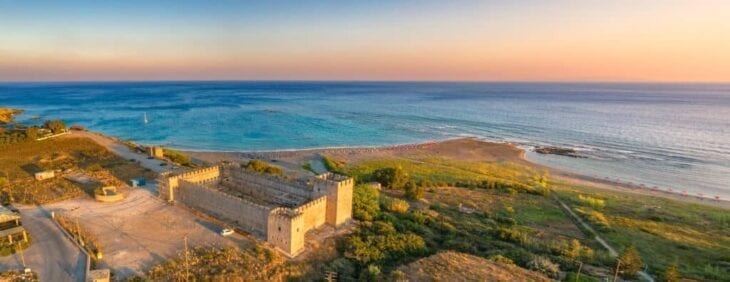
What are the best beaches to visit in Crete with kids and toddlers?
Listed below are the top beaches to visit in Crete with kids and toddlers.
- Best Beach in Rethymnon: One of the top beaches in Rethymnon is Preveli Beach. It is a picturesque natural area with a beach, palm trees and a lake for swimming and water sports. Preveli Beach is situated 35 kilometres from Rethymno and 10 kilometres from Plakias.
- Best Beach in Lasithi: Vai Beach is surrounded by Europe’s largest palm tree forest. Free camping was illegal but it offers smooth sand, clear water and natural beauty. Vai Beach is a gorgeous spot on Crete’s eastern coast for its thick palm forest, which creates a lovely backdrop against the pristine waters of the Mediterranean Sea.
- Best Beach in Chania: Balos Beach is one of the best beaches in Chania. It has unique waters, a silky white beach and a Venetian Castle island. Visiting Balos Beach takes some planning and preparation. The beach is located on the island’s northwest shore with an isolated position and difficult terrain.
- Best Beach in Heraklion: Matala Beach is one of the best beaches in Heraklion. The beach was a favorite hippie hangout in the 1960s and 1970s. It attracts families because of its sandy beach and accessible vacation tours. Matala Beach is recognized for its breathtaking beauty and thrilling caves. Matala is a lively village 75 kilometres southwest of Heraklion, Crete, Greece.
What are the top snorkeling spots in Crete that require a car to reach?
Listed below are the snorkeling spots in Crete that require a car to be reached.
- Kolokytha Beach. Kolokytha Beach, on Crete’s eastern coast near Elounda, offers a unique snorkeling experience with clear waters, vibrant marine life, and a mix of sand and rocky seabeds. Its remote location requires a car for access, as public transportation does not reach it. The journey, best undertaken with an SUV or a car with good ground clearance, includes navigating an unpaved, rugged road. Snorkelers enjoy observing various fish species and sea plants while snorkeling in Kolokytha Beach.
- Dragon’s Beach. Dragon’s Beach, on Crete’s southern coast near Lentas, is an great snorkeling places. The beach’s secluded location requires a car for access, as public transportation does not reach it. The journey involves navigating best suited for an SUV. Snorkelers enjoy observing various fish species and sea plants in a pristine environment. The beach remains uncrowded, providing a peaceful setting for underwater exploration. A car ensures flexibility and convenience, allowing visitors to carry necessary snorkeling gear and supplies.
- Loutro. Loutro, a village on Crete’s southwestern coast, is popular for snorkeling. The village lies near a small bay with crystal-clear waters, making it perfect for underwater exploration. Snorkelers encounter a variety of fish and marine life thriving among the rocky seabed and underwater caves. Reaching Loutro requires a car due to its remote location, as public transport is limited. The journey involves driving through winding mountain roads and scenic landscapes, adding to the adventure. Renting a suitable car or SUV ensures a smooth trip. Once in Loutro, visitors can enjoy the underwater world, with the convenience of having their vehicle for transport and carrying snorkeling gear. The village offers basic amenities, but the primary draw remains its underwater attractions. Snorkeling in Loutro provides a memorable experience, thanks to the diverse marine life and clear waters. The necessity of a car enhances the adventure, making the journey as rewarding as the destination.
- Aspes Beach. Aspes Beach, on Crete’s southern coast near Arvi, stands out for natural beauty and snorkeling conditions. The beach features clear, calm waters ideal for observing marine life. Snorkelers encounter various fish species and unique underwater rock formations. Reaching Aspes Beach requires a car due to its remote location, as public transportation does not service the beach directly. The journey involves navigating winding, unpaved roads with scenic views. An SUV or a car with good ground clearance is recommended for safely traversing the rugged terrain. Renting a suitable vehicle from nearby towns ensures a smooth trip. Once at Aspes Beach, visitors benefit from having their vehicle for transport and carrying snorkeling gear. The beach remains uncrowded, providing a peaceful environment for underwater exploration. Snorkeling at Aspes Beach offers a rewarding experience due to the pristine waters and diverse marine ecosystem. The necessity of a car adds to the adventure, making the journey as enjoyable as the destination.
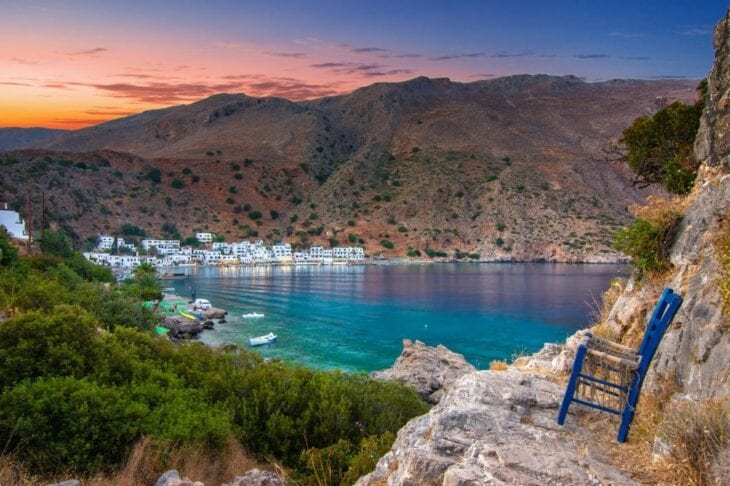
Should you rent a car for a snorkeling trip in Crete?
Renting a car for a snorkeling trip in Crete is highly recommended. Crete has numerous hidden snorkeling spots and coastal routes best accessed by car. Crete car rental offers flexibility to explore the island at your own pace, allowing visits to remote locations that public transportation may not reach.
With a rental car, you can plan trips to top-rated snorkeling sites, family-friendly locations, and hidden gems. It also provides the convenience of carrying snorkeling gear and other essentials. Driving along Crete’s scenic routes enhances the experience, offering views and the opportunity to discover villages and beaches.
There are budget-friendly car rental options, for those concerned about budget. Many companies offer hybrid or electric vehicles for eco-friendly options. Renting a car in Crete ensures a safe, flexible, and enjoyable snorkeling adventure, whether you’re a seasoned snorkeler or a beginner.
Last updated on January 5th, 2025














